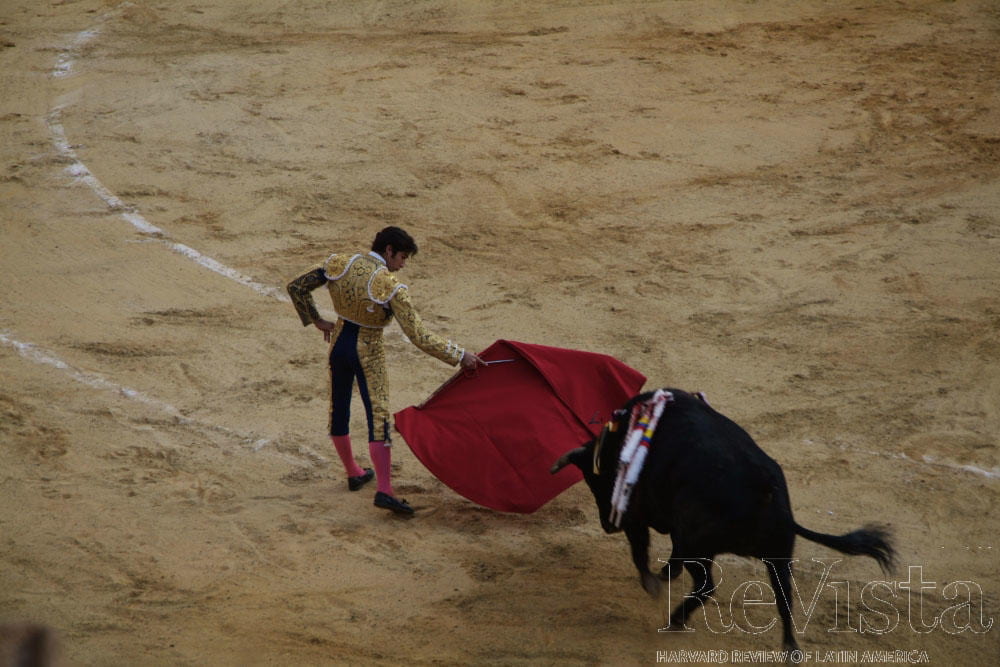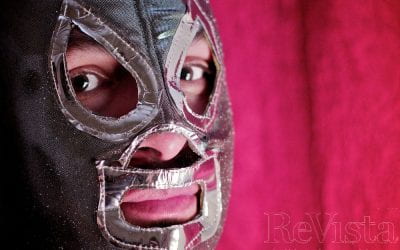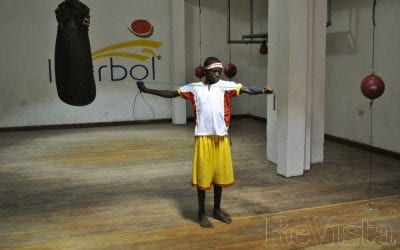Bullfights
Spain’s history is not written in ink, but in bull’s blood. The shadow of the black beast with sharpened horns has spread over the Iberian peninsula for thousands of years and extended to Latin America.
The poetry of the Siglo de Oro—the Spanish Golden Age that spans the 16th and 17th centuries—frequently makes reference to kings who confronted bulls, and celebrations that were only complete if they were accompanied by the threat of angry bulls.
A Unique Animal
When the Priest Dies
spiralled easily into the thousands.
Rejecting the Bullfights; Loving the Bulls
Las corridas de toros
Un arte, no un deporte
La historia de España no se escribe con tinta sino con sangre de toro. La sombra de una bestia negra de cuernos afilados resopla desde hace miles de años en la península ibérica.
Cualquiera que mire las figuras rupestres de las cuevas de Altamira, en el norte de España, notará la presencia de una figura que en algunos casos guarda una actitud plácida y en otros una posición agresiva. Son, hace 15 milenios, los antepasados de los toros.
Según algunos historiadores, los conquistadores romanos llevaron hace 23 siglos a España los festejos de circos, unos lugares públicos dedicados a ofrecer diversos espectáculos, a menudo crueles. En el curso de los años se produjeron allí luchas entre hombres y toros. Allí surgieron los primeros genes de las corridas, que encontraron arraigo popular inmediato.
En el siglo XI, el poema épico de Rodrigo Díaz de Vivar (Mio Cid) relata un famoso episodio en que este héroe, enemigo de los invasores árabes, lancea a un toro desde su caballo. Siete siglos después, el pintor Francisco de Goya ilustró la escena en uno de sus dibujos.
La poesía del Siglo de Oro –XVI y XVII— alude con frecuencia a reyes que se enfrentan a toros y celebraciones que solo son completas si las acompaña la amenaza de unos toros bravos.
Pero una cosa es el deporte de matar toros, comparable a la pesca o la cacería, y otra cosa es la tauromaquia, el arte de enfrentarse a un toro de media tonelada de peso valiéndose solo de un pedazo de tela (capote y muleta) y una espada anacrónica (estoque). Con esos pocos elementos, y la ayuda del picador y los banderilleros, que le quitan fuerza pinchándole el morrillo, el torero debe obligar al toro a acatar las órdenes del trozo de tela, correr a determinada velocidad y agachar la cabeza para facilitar su muerte con la espada antes de que transcurra media hora.
Los españoles aficionados a los toros no permiten que se llame deporte a lo que consideran un arte. Es como si se midiera la belleza de un óleo por los bíceps del artista o el talento de una bailarina por su capacidad de andar en puntillas. Tampoco les entusiasma que se mencione al lado del boxeo. Los aficionados, en realidad, aceptarían que se equipare la tauromaquia al ballet antes que al boxeo. Para ellos, la sangre, en la corrida de toros, es apenas un accidente inevitable. Lo que está en juego es más que la sangre: son la vida y la muerte.
Un animal único
Durante siglos el toreo fue una forma de combate en la que un jinete atacaba con lanzas a un toro. Pero se dice que a principios del siglo XVIII, un hombre llamado Francisco Romero se apeó del caballo, tomó un capote y un estoque y se enfrentó a muerte al toro cara a cara, cuerpo a cuerpo, metro a metro y en condiciones de franca desventaja. Ese hombre era un joven carpintero de Ronda, la legendaria ciudad española donde escribió novelas Ernest Hemingway, poemas Rainer Maria Rilke y está enterrado Orson Welles. La familia Romero fundó el toreo como se le conoce hoy.
Desde entonces hasta hoy –casi 300 años—han evolucionado mucho más los toros que los toreros. En todas partes, hasta en Suiza, hay toros que embisten si se los provoca. Pero el toro de lidia es diferente. Es el producto de decenas de generaciones en que el cruce de sangres y razas produce un animal fornido, de cuernos agudos y fiereza inextinguible, que embiste al hombre siguiendo unas cuantas características que lleva inscritas genéticamente. Entre ellas, que no conoce la cobardía, que se muestra más agresivo mientras más herido se siente y que insiste en atacar hasta el último instante de su vida.
Ejemplares como estos no venden en cualquier feria ganadera. “El toro de lidia –dice el historiador Federico Carllos Saizn de Roble—es un tipo zoológico artificial, creado exclusivamente para la Fiesta”. Solo en España, Portugal, Francia y algunos países de América Latina se crían toros de lidia. En otros puntos del planeta puede haber toros temperamentales (¿qué tal, por ejemplo, el iracundo corcoveo de los rodeos norteamericanos?) Pero no bravos.
De allí la mortal paradoja que envuelve el debate sobre la proscripción o tolerancia de las corridas: si se prohibiera lidiar toros bravos para protegerlos de la muerte a estocadas, esta raza desaparecería.
Cuando el sacerdote muere
Los toros son producto de una lenta y cuidadosa selección de linajes, pero la fiesta en que se enfrentan con los toreros es netamente popular. A diferencia de muchos de los deportes que hoy atraen multitudes, no nació en el jardín de un palacio ni en las reuniones de un club. Nació abajo, muy abajo, en los festejos campesinos y en las celebraciones de los santos patrones. Los toros han vivido en el alma española desde antes de que España existiera, están integrados a su lenguaje, constituyen su símbolo más singular y despiertan una curiosa y antigua pasión.
De muchas maneras, ellos representan una metáfora religiosa que, como la misa cristiana, exige un sacrificio central, unos sacerdotes consagrados, unos trajes ceremoniales, unos ritos seculares, un ofertorio de la víctima y una atmósfera presidida por la muerte.
Pero, a diferencia de la mayoría de las religiones, el sacerdote expone la vida en el ritual del sacrificio. Juan José de Bonifaz, el historiador que lleva con mayor cuidado las estadísticas sobre toreros muertos, habla de “centenares de fallecidos”. Entre 1771 y 1991 han muerto corneados cerca de 500 toreros. Esto es, uno cada semestre. Hace dos siglos había mayor número de víctimas, pero la penicilina –objeto de un monumento en la Plaza de Las Ventas de Madrid, la más importante del mundo—ha evitado cifras que podrían haber rondado los varios miles.
Con todo, muchos toreros famosos han dejado la vida en las plazas. Entre ellos, varios de los fundadores del arte y no pocos toreros modernos. Figuran en la fúnebre lista Pepe Hillo, Pepete, Espartero, Gallito, Joselito, Paquirri y el más legendario de todos: Manuel Rodríguez Sánchez, Manolete. Cuando este cayó herido mortalmente en la pequeña ciudad española de Linares, en 1947, hubo consternación internacional. Es como si Mohamed Ali hubiera muerto de un gancho de derecha en pleno ring. Tenía 30 años.
Rechazo a los toros, amor al toro
La “fiesta nacional”, como se denomina a los toros en España, se trasladó a sus colonias americanas junto con los virreyes, los soldados, el vino y el jamón. Durante varios siglos se lidiaron corridas en casi todos los países de Hispanoamérica. Argentina y Uruguay, famosos por su ganadería de carne, tuvieron plazas de toros y en Montevideo murió algún torero.
Hoy solo son taurinos México, Colombia, Venezuela, Ecuador y Peru. En Europa, además de España, Francia y, dentro de una modalidad más deportiva que artística, Portugal.
Desde hace 20 o 30 años, la corrida de toros enfrenta dos grandes enemigos: los altos precios del espectáculo y la oposición de grupos antitaurinos cada vez más agresivos. Por eso empiezan a formarse dos Españas: la España turina, que encabezan Andalucía, Valencia y Madrid –donde la fiesta de toros fue declarada “bien de interés cultural”—y la España antitaurina, liderada por Cataluña, que este año prohibió las corridas.
Con fiesta o sin fiesta, el toro negro y corpulento sigue siendo la sombra milenaria de España. No es una casualidad que en todas las carreteras del país estén prohibidos los avisos de vallas, salvo uno que representa un desafiante toro de lidia. Después de la bandera, es el símbolo más reconocible de esta tierra donde el rey es el más entusiasta de los aficionados.
Spring 2012, Volume XI, Number 3
Daniel Samper, a 1981 Nieman Fellow, is a Colombian journalist who has resided in Madrid for many years. A columnist for El Tiempo of Bogotá, he is the author of many books, including No es porque sea mi hijo, Piedad con este pobre huérfano and El huevo es un traidor.
Daniel Samper, a 1981 Nieman Fellow, is a Colombian journalist who has resided in Madrid for many years. A columnist for El Tiempo of Bogotá, he is the author of many books, including No es porque sea mi hijo, Piedad con este pobre huérfano and El huevo es un traidor.
Related Articles
Santo and Lucha Libre
English + Español
First Fall: They will fight two of the three falls without a time limit! One of my earliest childhood memories is of sitting in front of a small black-and-white television…
To Dance or to Box
English + Español
It’s Sunday, the streets are dusty and the only arrivals to San Basilio de Palenque are some motorcycle-taxis and an old bus from the village of La María. Peddlers descend from the taxis…
Women’s Soccer in Brazil
“No one knows, no one saw,” reads the headline in an important Brazilian newspaper announcing the conclusion of the main women’s soccer championship on the continent—the Taça…





